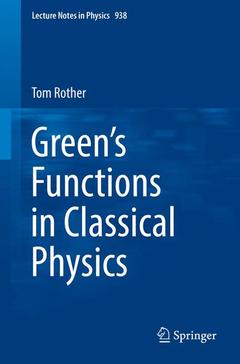Description
Green’s Functions in Classical Physics, 1st ed. 2017
Lecture Notes in Physics Series, Vol. 938
Author: Rother Tom
Language: English
Support: Print on demand
Description
/li>Contents
/li>Biography
/li>Comment
/li>
This book presents the Green?s function formalism in a basic way and demonstrates its usefulness for applications to several well-known problems in classical physics which are usually solved not by this formalism but other approaches. The book bridges the gap between applications of the Green?s function formalism in quantum physics and classical physics. This book is written as an introduction for graduate students and researchers who want to become more familiar with the Green?s function formalism.
In 1828 George Green has published an essay that was unfortunately sunken into oblivion shortly after its publication. It was rediscovered only after several years by the later Lord Kelvin. But since this time, using Green?s functions for solving partial differential equations in physics has become an important mathematical tool. While the conceptual and epistemological importance of these functions were essentially discovered and discussed in modern physics - especially in quantum field theory and quantum statistics - these aspects are rarely touched in classical physics. In doing it, this book provides an interesting and sometimes new point of view on several aspects and problems in classical physics, like the Kepler motion or the description of certain classical probability experiments in finite event spaces. A short outlook on quantum mechanical problems concludes this book.
Prologue.- About the State of Physics.- Basic Structural Elements of Physics.- About Classical Physics and Quantum Mechanics.- Green's Functions of Classical Particles.- The Simple Harmonic Oscillator.- The Damped Harmonic Oscillator.- Elementary Motions of a Point Mass.- Lippmann-Schwinger Equation.- Two Systematic Ways to Derive Green's Functions.- Temporal Boundary Value Problem of the Harmonic Oscillator.- Two Simple Interaction Processes and Huygens' Principle.- Particle Scattering on a Rigid Sphere and Kepler Problem.- Green's Functions of Classical Fields.- Comments on the Field Concept.- The Elastic String.- Poisson Equations of Higher Dimensions.- Wave Equations of Higher Dimensions.- The Scalar Helmholtz Equation.- Scattering Problems.- Probability Experiments and Green's Functions in Classical Event Spaces.- Probability Experiments in a Two-Dimensional Event Space.- Probability Experiments in a Four-Dimensional Event Space.- Outlook or Something Like an End.- Classical Free Point Mass and Green's Function of the Diffusion Equation.- Schrödinger Equation of the Free Particle and Green's Function.- Classical Fokker-Planck Equation and Schrödinger Equation.- A Relation Between the Green's Functions of the Klein-Gordon- and Dirac Equation.
Dr. Tom Rother was born in 1957 in Wolfen, Germany. He received the Dr. rer. nat. and Dr. habil. degrees from the University of Greifswald in 1987 and 1999. Since 1987, he has been with the German Aerospace Center. In 1990, he received the Young Scientist Scholarship of the URSI, and in 1991 a special grant of the Alexander von Humboldt Foundation. He is a Senior Scientist of the German Aerospace Center since 2004. Dr. Rother’s research interests are in quantum statistics of charged particle systems, in electromagnetic wave theory, and in quantum optics. With Springer he has published 2 books on electromagnetic wave scattering on nonspherical particles.

